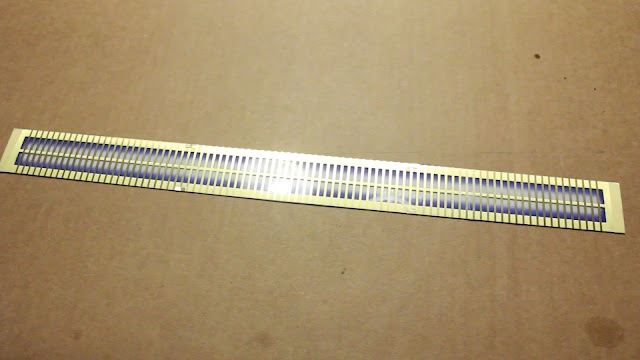So I built this little housing out of a styrene sheet. I cut some strips 2mm wide and 4mm long and glued them together, then primed and painted it black.
And then carefully glued it in place over my monitor.
I also purchased a 3D printed cockpit cabin door. The kit came with a sticker which you place on the back wall to simulate the door. Here is a before shot....
The other problem with this is that the door is inset about 3/4" back. In reality, the door is almost right up against the frame. So I got this 3D printed door from Shapeways.....
Painted and detailed it...
Added some red fiber optic to the lock mechanism console...
And here we have it installed in the cockpit. Looks sooooo much nicer than the sticker, which was also difficult to see because of being set back so far. You can see the red light in these 2 photos I took below. One with the back wall lit and one with just the red lock lights.
So on to finishing up the cockpit. So I assembled the 3 pieces of the cockpit nosecone together. This consisted of an upper and lower half, and then the nose itself.
There was a decent visible seam between the upper and lower half, which you can see here.
So I puttied and sanded it smooth and shot it with primer and voula. A nice clean panel.
Once painted with the body color, I then taped off the areas to be painted gray.
Airbrushed those in and then did blast marks and panel markings with the gray. I also did a light dusting of a red brown to add just a hint of color so it's not all just gray.
With the nosecone now done, it's time to move on to the cockpit tube. One of the first things I wanted to do before any painting was add the 2 red lights found on the outside of the cockpit, which you can see in this screen cap.
So I marked the 2 holes that needed to be drilled out and did so.
I then soldered a couple of red LEDs together spaced apart the exact distance needed to fit in the 2 holes.
And a test of the LEDs.
So the next thing was to paint the inside of the cockpit tube. I did this with black spray paint so that no light would leak through the plastice model from all of the LEDs and fibers used in the cockpit.
I also had to grind down some of the model to make room for the LEDs, so that the back wall of the cockpit would fit in place.
And I also had to notch the back wall itself to allow the leads of the LEDs to come through.
So at this point I glued the LED's into place...
Then glued the 2 halves of the cockpit tube together. But there is a seam in the model that needs to be dealt with. So I puttied the seam up here.....
Then sanded nice and smooth.
So then it was time to preshade the panel lines black...
Apply the body color and then tape off the gray areas to be airbrushed...
So I purchased a photo etch piece of ribbed work to apply around the cockpit ring. The model just has the ribbed ring molded into the plastic, but I wanted more depth, and also to conceal the holes for the lights a little better.
So this is the photo etch piece...
Which will wrap around the cockpit tube...
So I primed and painted the etch strip...
And then glued in place...
So it's now time to finish weathering and painting the cockpit tube.
Then glue the cockpit nosecone to the tube...
Some black washing on the bottom side for detailing....
And some of the dirty yellowing seen on the real filming miniature...
And... we then have a completed cockpit.
So I'm just about done. All that's left is attaching the cockpit to the upper hull, painting the upper hull, than attaching to the bottom.
So stay tuned. MORE TO COME....







































































































